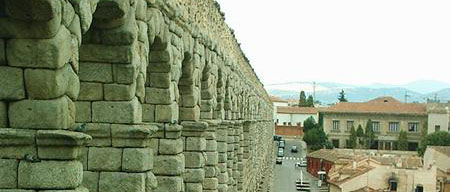Home > Study in Spain > City Guide > Segovia
Segovia City Guide
- Places of Interest
- Maps
- Getting to
- Getting around the city
Located 50 miles north of Madrid at 1,000m above sea water, the city of Segovia is a UNESCO World Heritage Site and is the capital of the province of Segovia in the autonomous community of Castile and Leon. The city is small and easily manageable and perfect for taking idyllic strolls as well as passing-by magnificent world famous sights such as the Aqueduct and the Alcázar Palace of which Walt Disney's Cinderella Castle is known to have been based.
In addition to its plethora of monuments, the scenery from its various miradors is more than just breathtaking. With views over into the snow-capped mountains and its rich and abundant green woodland, Segovia's beauty is on another level. In the old town can be find a number of paths and passages leading on to the authentic tapas bars of the local residents and which unexpectedly open up onto the overflow of vegetation. Segovia is a city that will not fail to disappoint and has a magnificently rich history of cultural and religious invasion.
Places of Interest
The Aqueduct
This is Segovia's most prized monument and is its most significant and best-preserved left behind by the Romans on the Iberian Peninsula during the 1st century AD. It is even on the city's coat of arms and stands as the city's symbol. With 166 arches, and full of vast history, this UNESCO World Heritage Site was still being used until recently. It runs all along the city and the best view of it is in the old centre.
The Cathedral
The city's cathedral takes on a gothic style with construction starting in the early 16th century. The cathedral has a number of beautiful facades however the tower, which is located on the Epistle side, is by far one of the cathedral's most breathtaking features and was where the bell ringer lived until the mid 20th century. The cathedral contains 18 chapels and a grand interior and entrance is a mere 3€. This also contains entry to the cloister and museum which definitely makes it worth your money!
The Alcázar
Dating back to the 11th century, Segovia's Alcázar Palace is decorated in a number of styles such as Romanesque, Gothic, Mudejar and Renaissance. This palace has been of great significance to Spanish history for example it was the residence of Isabella the Catholic, the site of the wedding of Phillip II and is currently being used as a museum. It is even famed for being Walt Disney's inspiration for Cinderella's Castle. The Alcázar has a breathtaking view over into the mountains and vast green forest and its interior contains a host of exquisitely-decorated rooms. And to experience all this for only €6 – definitely a visit that should be made during your visit!
The City Walls
Segovia's vast and stretching city walls are 3,000m long in total and both start and end at the Alcázar. Constructed of limestone and strengthened in parts with large granite blocks, the walls once had a total of five gates however there are only 2 which still survive to this day.
San Juan de los Caballeros Church
This church is famed for being one of the oldest in Segovia and is situated on an early Christian basilica. In 1905, Daniel Zuloaga bought it and made it both his home and ceramics workshop. The nobility of Segovia are buried in this very church and it is currently being used as a museum dedicated to Zuloaga's family with a large collections of ceramics and an archive of documents.
Museums
Museo de Segovia
Originating back to 1842, this museum was once the Provincial Museum of Fine Arts. The museum holds a number of works of art from convents and monasteries which were not deemed suitable for Madrid's El Prado museum. Examples of the collection are two Celtiberian boar statues, Roman mosaics, various paintings and sculptures and a fascinating collection of coins from Segovia's mint. The museum has changed location many times and is currently being set-up for its new location in a fortification of the city wall. Entrance is 1,20€ during the week and free at weekends.
Cathedral Museum
This was established in 1824 by bishop Manuel Castro Alonso and there are paintings by a number of Flemish and Spanish artists in one of the rooms leading off from the cloister. This same room also prizes a number of artefacts and precious metals. There is a vast collection of tapestries situated in the Chapter House with its glorious Renaissance ceiling as well as an archive with documents dating all the way back to the 12th century.
The Zuloaga Museum
Residing inside the church of San Juan de los Caballeros, this museum started in 1905 when Daniel Zuloaga wanted to set-up his workshop there. Ignacio Zuloaga's paintings can be seen within as well as paintings and ceramic work by Daniel and his children. The church also houses the tomb's of Segovia's nobility.
Maps
Getting to Segovia
By Train
Segovia can be reached in 2 hours by train (Cercanias) from Madrid and costs €6 for a one-way train ticket. From the train station, you can get bus number 8 straight into the town centre. Another option is the AVE or new high-speed train which has a route which runs to Madrid in under 30 minutes and it is also connected to a large number of other Spanish cities. The station is called Segovia-Guiomar and is 5km from the city, however there are bus links every 15 minutes from the aqueduct.
By Bus
Segovia is only 50 miles from Madrid and can be reached in 1 hour by bus from Madrid Principe Pio bus station arriving at Paseo de Ezequiel Gonzalez, near Segovia's aqueduct. Buses between Segovia and Madrid run very regularly every 1 or 2 hours.
Getting around the city
By foot
Segovia is a relatively small, manageable city and is full of beauty at every turning, especially in the old centre. This is why travelling by foot is probably the best option to explore the town and discover what it has to offer. The roads tend to be small too and by foot it is easier to find what you are looking for, also parts of the city are closed to vehicles. However, wear some comfortable shoes as you will definitely be climbing uphill and walking around a lot!
By bus
If you do get tired walking, there is a bus service however it's very limited as walking is the norm in the city.
By bike
For the past 2 years there has been the option to hire a bike and get some exercise as well as getting to grips with the city. Bikes are available to hire at the cathedral and also close to the tourist information office. This is located at the aqueduct and information as to how to go about it can be found here.

